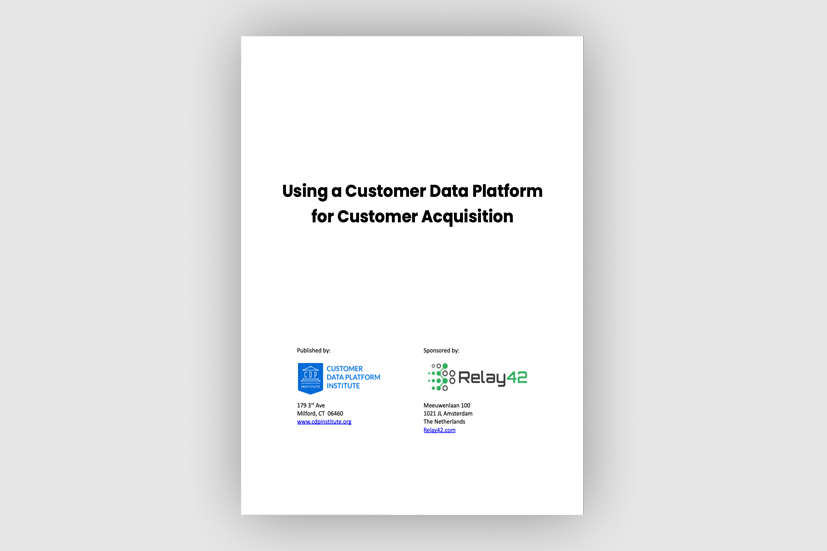3 Ways a Customer Data Platform Delivers More Revenue
by Anthony Botibol on 20.4.2023

While Customer Data Platforms (CDPs) have been available in the market for some time now, there are currently so many solutions that it can be confusing for businesses to choose the right one that fits their needs. As one of the CDP solutions on the market, we, of course, are a bit subjective. However, in our daily work with marketing and business leaders, we've noticed that many of them want to get back to basics and understand how a CDP can help their business grow. In the coming weeks, we'll try to help marketers get a better understanding of the potential that the technology has to help them solve their marketing challenges.
Here's the first article of our new educational series on CDPs.
Back to basics: What is a Customer Data Platform?
A Customer Data Platform (CDP) is a data management technology specifically used by marketing teams for the purpose of replicating all available customer data, storing it centrally, and transforming the raw data into unified customer profiles that can in turn be used for better customer intelligence, segmentation, and personalization of customer interactions.
The CDP is designed to find common identifiers between specific customer records across multiple data sets. For example, for many companies, one of the most common challenges is connecting online and offline customer data.
Validating that a customer who has purchased via the website is the same customer who has previously purchased 5 times via offline methods (perhaps through a store or call center), and then joining the data from both systems into a single customer profile enables the business to understand that the customer has in fact purchased six times, know what was purchased, what was viewed, how they bought, what they abandoned from their cart, what was returned…etc.
Understanding all this information about one customer, and scaling that intelligence across millions of customers in a way that can be activated into marketing channels, is where many benefits are derived with a CDP.
Watch the on-demand webinar: CDP foundations with the founder of the CDP Institute.
Once those unified customer profiles have been achieved through identity resolution inside the CDP, there are many new ways that businesses can then utilize their customer data to deliver revenue growth. Here are 3 ways to do so:
Benefit 1: Predicting the next best product to present to an existing customer
To be effective at upsell and cross-sell you need to understand what product(s) a customer is most likely to purchase from you next. When brands can understand this more accurately, and therefore move away from every customer getting the same offers, they see dramatically improved results. Understanding or predicting that next offering is of course not always straightforward, and the more customers and products you have, the harder it gets.
A Customer Data Platform helps marketing teams because it firstly ensures that all the data you need to best understand the next best offer is stored and structured in a trustworthy way. As mentioned, identity resolution is a capability that resides within most CDPs to join all the transactions, clicks, likes, complaints, and any other piece of data about customers to a specific person (or unique device in the case of unknown customers that may be actively researching your brand on-line but have never authenticated themselves via a form.)
The stronger the ID resolution for matching identities, the more useful your data becomes, and while many businesses have home-grown data lakes and CDP-like solutions they tend to not be great for providing high identity match rates between online and offline channels.
With all interactions tied to an individual customer profile (or anonymous profile), you can have trust that you will make customer-centric decisions based on good facts, and then use data analytics to look for patterns that can then predict what other similar customers usually purchase next.
Perhaps their age, original source, and last product purchased all combine to suggest that other customers with the same profile have a unique but significant correlation towards purchasing the exact same product again within 90 days. If so, then retargeting them with ads for the same product should follow that significant correlation, and provide an improved level of conversions than if you targeted them with an ancillary product based on a hunch.
Essentially, marketers can analyze and discover the best match of product(s), offer(s), and channel(s) to drive a conversion from a customer. But what about 3M customers?
High-scale personalization for huge volumes of customers is where the CDP really provides maximum benefit as it enables you to run the same analysis but across your entire database of known AND unknown customers.
For the known customers, you can let the CDP make the decisions about the best channel, offer or product across the full scale of the database, using all the necessary data inputs to spot those significant correlations for each individual profile. With integration to your owned and paid marketing channels, the CDP can then orchestrate those channels to run in the most optimized sequence, with an omnichannel personalized offer that ultimately garners more conversions.
For businesses that have not yet invested in a Customer Data Platform, this ability to better personalize the interactions and offers across many channels is where significant growth can be achieved at all stages of a customer lifecycle from awareness to acquisition to loyalty and retention.
Benefit 2: Identifying and activating anonymous website visitors in owned and paid channels
Despite its name, a ‘Customer’ Data Platform does not only store and unify data about existing or known customers but also does the same for anonymous website visitors. With the majority of website users not authenticating either through a purchase or form submission, a CDP that can identify returning anonymous visitors to personalize the offers they see on the website or can capture and activate an unknown profile in a paid acquisition channel, will drive up conversions.
Of course, many of the visitors on your website may indeed be existing customers, prospects, or fake traffic, but again there are CDPs that have highly sophisticated (and compliant) ways to recognize a customer even when they don’t log in or authenticate. This enables you to deploy tactics to convert more unknown visitors, but more importantly, push huge volumes of consideration-stage prospects toward purchasing your products through real-time off-site retargeting and real-time on-site personalization.
There are actually many ways to capture anonymous website behaviors and there are many ‘real-time personalization’ solutions on the market today. Most of these platforms enable you to personalize the on-site website experience based on the user’s clickstream history and so for a single use case to identify and activate anonymous website visitors there are cheaper solutions than a CDP, however, some CDPs are in fact born from this technology category but have expanded their scope to also ingest and unify customer data from eCommerce and CRM solutions to make the personalized experience far more accurate and impactful.
Read more: How to use identity resolution to personalize the experience to unknown customers.
Some CDPs also have this capability baked into the platform and a highly versatile array of real-time connectors to paid and social channels alongside direct marketing channels. The ability to coordinate a complex mix of channels to optimize the conversions from your anonymous website visitors is usually made easier too with customer journey orchestration.
Benefit 3: Business-changing decisions don’t get made based on bad facts
Looking inside your eCommerce platform at the end of a Black Friday will see record sales and some potential VIP customers who’ve purchased multiple high-ticket products and hit the threshold for some highly exclusive offers and events.
A decision to target these VIPs with a $5 catalog might feel like a good idea – after all, it’s worked in the past to bring in more revenue from these high spenders - but by combining this data with your offline returns data you find out that 50% of your VIP segment actually returned 4 or more items to their local store, and are in fact much lower in value than previously thought.
Although a simple example, this is one that is (a) a real issue with a UK retailer that was solved with a CDP, and (b) just one of many hundreds of potential use cases that once all realized through reliable and centralized data can lead to many $millions of savings or potential revenue increases through better business decisions.
To better understand multi-touch attribution, customer journey flows, true lead sources, lifetime value, or even the simplest of answers to questions like ‘how many customers do you have?’ the CDP becomes the one central source of truth for all your customer-related business questions and decisions.
A CDP helps to better answer the simple questions as much as the difficult ones, and it is often miscalculations or misrepresentations of data that can lead to ‘bad facts’, which lead to incorrect business decisions.
For example, forecasting 'X thousand' new customers in a year based on the last 5 years of transactions is a great way to plan for growth in a data-driven business, but if the data pulled from the accounting system has not joined multiple transactions to a single repeat customer, then the results are inherently wrong.
Similarly, pulling all customers and transactions from the eCommerce system will provide another view of the last 5 years of online purchases, and the CRM or POS may provide different results again, and you will often find none of them add up to the same numbers. This is where the CDP helps by centralizing the data from all these systems into one place that the entire business can then draw reliable insights from in a consistent and more accurate way, without the inefficiencies to boot.
Bad or siloed data leads to bad facts, which leads to incorrect decisions, while good, consistent data leads to good facts, which leads to great decisions!
Download free e-book: Beyond the Tool: CDP as a Practice
In summary, a Customer Data Platform has thousands of micro and macro ways to increase your revenues and decrease cost inefficiencies, while also enabling you to make profitable business decisions using factual, reliable data. Here we’ve outlined just 3 ways to grow your business with a CDP, but if you’d like to explore more Customer Data Platform use cases, or discuss your own business potential from a CDP, then get in touch.
You May Also Like
These Related Stories

Customer Acquisition is Harder Than Ever in 2025. Here’s How the Right CDP Can Help

CDPs vs. DMPs - What Are the Differences?



.png?width=786&height=265&name=Relay42%20Demo%20Banner%20(1).png)